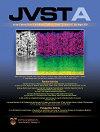Advanced two-objective optimization of thickness and large-area homogeneity of ZnO ultrathin films deposited by atomic layer deposition
IF 2.1
3区 材料科学
Q3 MATERIALS SCIENCE, COATINGS & FILMS
引用次数: 0
Abstract
Semiconductor thin films and coatings have become one of the most relevant research fields due to their significant applications in priority energy-related technologies such as solar cells, photocatalysts, and smart windows. Since all these fields are conceived as tools to fight against the effects of climate change, a real impact requires the successful deposition of semiconductor films on large-area substrates such as windows, panels, pipes, and containers, to give rise to photoactive components suitable for buildings, industries, cars, and parks. However, scalability remains one of the major issues in almost all methodologies known for the deposition of semiconductor films, irrespective of the phase approach used, i.e., either from vapor- or liquid-phase. Here, a mathematical metamodel was applied to simulate the atomic layer deposition (ALD) of zinc oxide (ZnO) ultrathin films (a versatile photoactive material in energy-related research) and optimized their thickness and homogeneity over the whole area of 8 in.-diameter Si wafers. Knowing all ALD parameters that define the quality and properties of the deposited films, we delimitated a set of four metamodel-inputs (zinc precursor dose, purge, and the inner and outer carrier gas flows) based on literature review, expertise, costs, and reactor design aspects specific to the deposition of ZnO. The average thickness and homogeneity of the films were established as the two outputs of the metamodel, which were the object of optimization. Using advanced iterative procedures, we carried out three rounds of experiments that lead us to a set of ALD parameters to deposit a ZnO ultrathin film with an average thickness of 11.38 nm that leads to a deposition rate of 1.9 Å/cycle, which represents 90% of the highest reported value for ZnO by ALD (2.1 Å/cycle). The homogeneity over the whole 8 in.-diameter wafer reached 2.61 nm, which represents the smoothest distribution of thickness values in the entire deposited area. Given the origin of the limits constraining this optimization procedure, our results hold promise in supporting the transition from the laboratory-level synthesis of thin-film-based optoelectronic devices to their large-scale production. This could ultimately help to circumvent the difficulties faced in scaling the ALD technology and enable alternative deposition methodologies such as thermal ALD, otherwise inaccessible to the production chain.原子层沉积法制备ZnO超薄膜厚度及大面积均匀性的先进双目标优化
半导体薄膜和涂层由于在太阳能电池、光催化剂和智能窗等优先能源相关技术中的重要应用而成为最相关的研究领域之一。由于所有这些领域都被认为是对抗气候变化影响的工具,因此真正的影响需要在大面积基板(如窗户、面板、管道和容器)上成功沉积半导体薄膜,以产生适用于建筑物、工业、汽车和公园的光活性组件。然而,在几乎所有已知的半导体薄膜沉积方法中,可扩展性仍然是主要问题之一,无论使用何种相方法,即从气相还是液相。本文采用数学元模型模拟了氧化锌(ZnO)超薄膜(一种在能源相关研究中用途广泛的光活性材料)的原子层沉积(ALD)过程,并优化了其厚度和均匀性。-直径硅片。了解了决定沉积薄膜质量和性能的所有ALD参数,我们根据文献综述、专业知识、成本和特定于ZnO沉积的反应器设计方面划分了一组四种元模型输入(锌前体剂量、吹扫以及内外载气流量)。将薄膜的平均厚度和均匀性作为元模型的两个输出,作为优化目标。利用先进的迭代过程,我们进行了三轮实验,得到了一组ALD参数,沉积了平均厚度为11.38 nm的ZnO超薄膜,沉积速率为1.9 Å/循环,这是报道的ZnO ALD最高值(2.1 Å/循环)的90%。整个8英寸的均匀性。-直径的晶圆达到2.61 nm,代表了整个沉积区域厚度值分布最平滑。考虑到限制这一优化过程的限制的起源,我们的研究结果有望支持从实验室级薄膜光电器件合成到大规模生产的过渡。这最终将有助于克服ALD技术规模化所面临的困难,并实现其他沉积方法,如热ALD,否则无法进入生产链。
本文章由计算机程序翻译,如有差异,请以英文原文为准。
求助全文
约1分钟内获得全文
求助全文
来源期刊

Journal of Vacuum Science & Technology A
工程技术-材料科学:膜
CiteScore
5.10
自引率
10.30%
发文量
247
审稿时长
2.1 months
期刊介绍:
Journal of Vacuum Science & Technology A publishes reports of original research, letters, and review articles that focus on fundamental scientific understanding of interfaces, surfaces, plasmas and thin films and on using this understanding to advance the state-of-the-art in various technological applications.
 求助内容:
求助内容: 应助结果提醒方式:
应助结果提醒方式:


